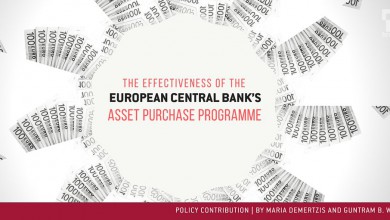The International Monetary Fund now estimates a 30% risk of deflation in the eurozone, and growth figures within the monetary union continue to disappoint. But policymakers seem trapped in a cat’s cradle of economic, political, and legal constraints that is preventing effective action. The fulfillment of policy rules appears to be impossible without growth, but growth appears to be impossible without breaking the rules.
German Finance Minister Wolfgang Schäuble is politically committed to outdoing his country’s tough domestic fiscal framework to secure what he calls a “black zero” budget. The French government is working to regain credibility on reform promises made in exchange for delays on fiscal adjustment, and Italy, with one of the highest debt burdens in the eurozone, has little room to use fiscal policy. Meanwhile, the European Central Bank is constrained by doubts about the legality of its “outright monetary transactions” (OMT) scheme – sovereign-bond purchases that could result in a redistributive fiscal policy.
With all of the rules pointing toward recession, how can Europe boost recovery?
A two-year €400 billion ($510 billion) public-investment program, financed with European Investment Bank bonds, would be the best way to overcome Europe’s current impasse. Borrowing by the EIB has no implications in terms of European fiscal rules. It is recorded neither as new debt nor as a deficit for any of the member states, which means that new government spending could be funded without affecting national fiscal performance.
Thus, some of the investment spending currently planned at the national level could be financed via European borrowing to relieve national budgets. Such an indirect way of dealing with strict rules would also be easier than starting long and wearying negotiations on changes to the fiscal framework.
The EIB is worried that such a scheme could come at the cost of its triple-A rating. Indeed, though it can currently borrow at 1.6% on a long maturity, it has used its recent capital-raising exercise to reduce leverage rather than substantially increase its loan portfolio, as would be warranted at a time of retrenchment in private lending. In any case, a rating change would hardly affect funding costs in the current low-yield environment, as lower-rated sovereigns have demonstrated.
In addition, the ECB could purchase EIB bonds on secondary markets, which would help to keep funding costs low – or even reduce them. More important, purchases of EIB bonds would enable the ECB to undertake quantitative easing without triggering the degree of controversy implied by intervening in 18 separate sovereign-bond markets, where concerns that ECB purchases would affect the relative pricing of sovereigns are very real.
Already, €200 billion of EIB bonds are available. Adding €400 billion would increase the pool substantially. Together with asset-backed securities, covered bonds, and corporate bonds, €1 trillion of assets – the threshold widely thought to make quantitative easing by the ECB credible – would be available for purchase.
A central question, of course, concerns the type of government spending that should qualify as investment spending, and which European investment projects should be supported. It will be impossible to define new and sensible European projects worth €200 billion per year. Common projects such as the European energy union will need more time to be precisely defined. As a result, the bulk of investment now will have to come from national policymakers.
In part, this means that existing infrastructure projects that are supposed to be financed from national budgets could be funded by the EIB. By removing some of the burden from national budgets, the current decline in public investment could be reversed.
Some of the new resources could also be used to allow for budget consolidation in France without pro-cyclical cuts. France could get this helping hand in complying with the fiscal rules in exchange for serious and necessary structural reforms, as could Italy, where EIB-funded bonds would provide a much-needed growth stimulus without new government commitments. In Germany, the freed-up resources could be used to accelerate existing investment projects while still meeting its black-zero pledge.
Similar arrangements could be found for the other eurozone countries. To prevent the misuse of money, the European Commission should vet all national investment projects. More broadly, the program would be an important step toward establishing the eurozone’s missing fiscal union. That goal will be reached more quickly once the benefits of achieving it are apparent to all.

